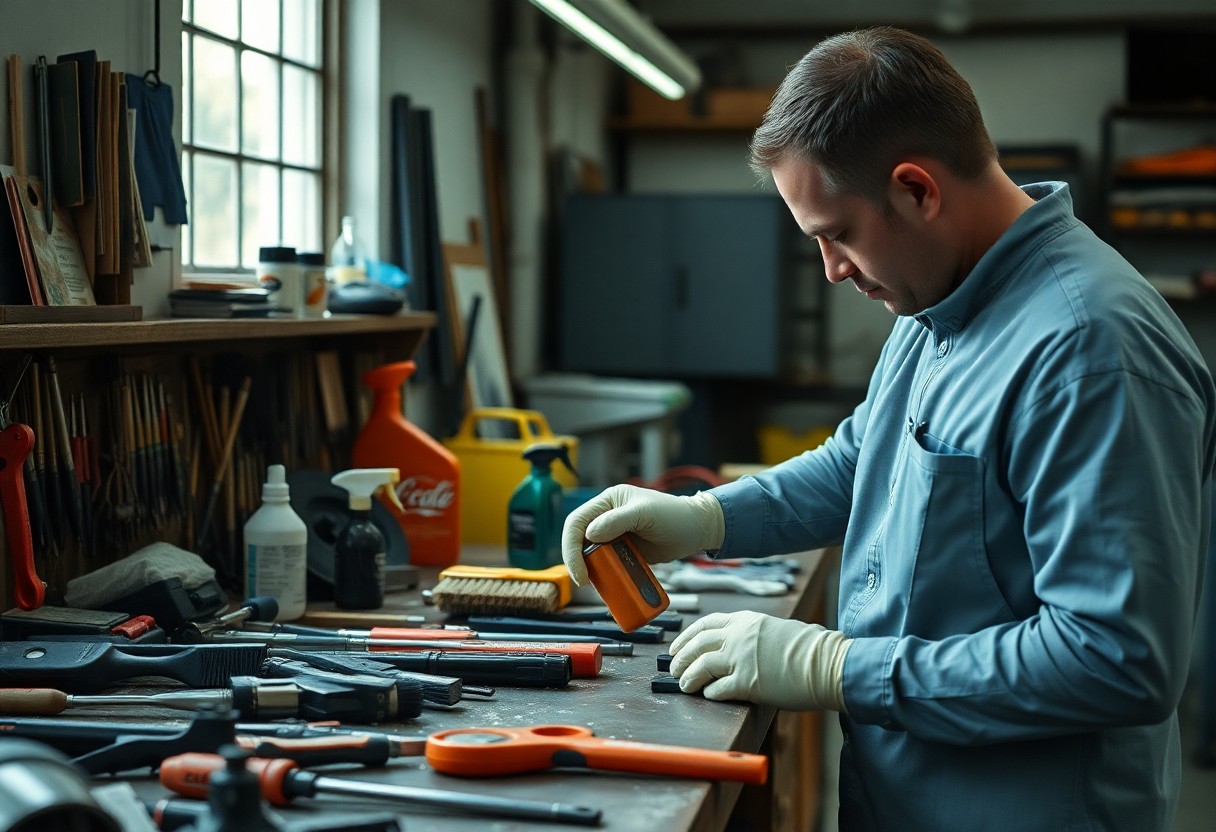You need to adopt the right techniques when it comes to cleaning your equipment to ensure both safety and performance. Proper cleaning not only extends the lifespan of your tools but also minimizes the risk of accidents caused by dirt and grime build-up. It’s important to follow manufacturer guidelines, use appropriate cleaning agents, and employ effective cleaning methods tailored to your equipment type. By understanding these practices, you can maintain optimal functionality and safeguard your investment for the long haul.

Key Takeaways:
- Always refer to the manufacturer’s instructions for specific cleaning guidelines to ensure the longevity and efficiency of the equipment.
- Use appropriate cleaning agents and tools that are suitable for the material and function of the equipment to avoid damage.
- Establish a regular cleaning schedule to maintain optimal performance and hygiene, addressing different components as needed.
The Fundamental Importance of Equipment Maintenance
Regular maintenance not only enhances efficiency but also extends the lifespan of your equipment. Neglect can lead to performance issues and costly repairs. By adhering to a consistent maintenance schedule, you ensure that your equipment remains reliable and efficient, effectively protecting your investment. This proactive approach saves money in the long run by reducing the frequency and severity of repairs.
Enhancing Longevity and Performance
Proper maintenance routines keep your equipment functioning at its peak. Regular inspections and timely repairs help prevent small issues from escalating into major breakdowns, directly influencing performance efficiency. For instance, lubricating moving parts significantly decreases friction, which results in smoother operation and reduces wear and tear, thus maximizing longevity.
Risk Mitigation: Reducing Accidents and Breakdowns
Inadequate maintenance increases the likelihood of accidents and breakdowns, leading to interruptions in workflow and potential safety hazards. Implementing a stringent maintenance strategy minimizes these risks. Regular checks can uncover hidden issues before they escalate, ensuring that safety protocols are observed and machinery operates smoothly.
For example, a construction site equipped with heavy machinery can benefit immensely from routine checks. According to industry statistics, machinery failure accounts for a significant percentage of workplace accidents. Equipment undergoing regular inspections is less likely to malfunction, drastically reducing risks of serious accidents. Failure to adhere to maintenance protocols can not only result in equipment downtime but could compromise worker safety. Thus, routine maintenance ultimately creates a safer working environment, safeguarding both personnel and assets. Maintain diligence in your equipment upkeep to ensure optimal safety and operational performance.

The Step-by-Step Guide to Equipment Cleaning
| Step | Description |
| 1. Assess Equipment | Identify the type of equipment and specific cleaning requirements. |
| 2. Choose Cleaners | Select appropriate cleaning agents and tools that suit your equipment. |
| 3. Prepare Workspace | Create a safe and organized area for cleaning. |
| 4. Clean Equipment | Follow the recommended cleaning procedure for your equipment. |
| 5. Inspect & Store | Check your equipment for any damages and store it properly. |
Assessing Equipment Type and Cleaning Needs
Understanding your equipment’s type and its specific cleaning needs sets the foundation for effective maintenance. Different materials, such as stainless steel, plastic, or glass, have unique cleaning requirements. For example, delicate electronic components may require special care to avoid damage, whereas heavy-duty machinery can handle tougher cleaning solutions. Consulting the manufacturer’s manual provides imperative guidance on the appropriate cleaning methods.
Selecting Appropriate Cleaning Agents and Tools
Selecting the right cleaning agents and tools is imperative for maintaining your equipment’s integrity and functionality. Based on the equipment type, you should choose non-corrosive cleaners for sensitive surfaces, while industrial-grade products may be necessary for heavy machinery. Microfiber cloths, soft brushes, and specialized scrapers are often recommended tools. This ensures that you avoid scratches and damage while maximizing cleaning efficiency.
Exploring various cleaning agents reveals a spectrum of options tailored for different applications. For instance, enzymatic cleaners work effectively on organic debris, making them ideal for food processing equipment. Conversely, abrasive cleaners should be avoided on softer surfaces, as they can cause irreversible damage. Reviewing product labels and conducting small spot tests can help you confirm compatibility with your equipment. Ultimately, the right tools combined with effective cleaning agents will enable you to maintain your equipment’s optimal functionality and lifespan.
Common Cleaning Mistakes and How to Avoid Them
Many people overlook simple cleaning practices, leading to costly damage or inefficient equipment performance. Overusing harsh chemicals, neglecting to check manufacturer guidelines, and not allowing adequate drying time are common issues that can significantly hinder cleaning efforts. Identifying these pitfalls will enable you to enhance your cleaning routine and ensure your equipment remains in peak condition.
Overusing Chemicals: The Hidden Dangers
Using too many cleaning chemicals can leave harmful residues on your equipment, posing serious health risks and potentially damaging sensitive surfaces. Stronger isn’t always better; excessive chemicals can corrode materials. Stick to recommended amounts and opt for safe, effective cleaning agents.
Ignoring Manufacturer Guidelines
Manufacturer guidelines are often tailored to maximize equipment performance and lifespan. Failing to follow them can lead to misuse, resulting in either ineffective cleaning or damage. Each piece of equipment may have specific recommendations regarding the type of cleansers, tools, and methods. For instance, using abrasive materials on delicate surfaces may cause scratches, while neglecting to follow recommended cleaning frequencies can result in buildup and malfunction. Always have the manual handy and stay aligned with the specifications it provides to protect your investment and ensure safe operations.
Best Practices for Maintaining Clean Equipment
Adhering to best practices ensures your equipment remains in optimal condition and reduces downtime. Regular maintenance not only extends the life of your gear but also enhances safety and performance. Always use the appropriate cleaning agents designed for your specific equipment and avoid abrasive materials. This attention to detail can drastically improve functionality and user satisfaction.
Establishing a Regular Cleaning Schedule
Creating a regular cleaning schedule keeps your equipment in prime working order. Consider the frequency of use when developing this schedule; heavy-use items may require daily cleaning, while lighter-used equipment can be cleaned weekly. Documenting these timelines helps ensure compliance and accountability among staff members.
Training Staff and Delegating Responsibilities
Proper training of staff in cleaning procedures promotes consistency and effectiveness in maintaining equipment. Assign specific responsibilities to team members, ensuring they understand the importance of their roles in the cleaning process. This delegation not only fosters a sense of ownership but also enhances efficiency, as each member becomes familiar with the best practices pertinent to their assigned equipment.
Provide hands-on training sessions to familiarize your staff with the equipment and appropriate cleaning techniques. Utilize checklists or guides that detail step-by-step processes, which can serve as valuable references during cleaning. Consider implementing periodic refreshers or audits to reinforce these practices. By encouraging open dialogue among team members, you can also identify any difficulties or uncertainties, leading to improved compliance and cleaner, safer equipment overall.
The Environmental Impact of Cleaning Products
Cleaning products are often overlooked for their environmental impact. Many traditional cleaners contain harmful chemicals that can contaminate water sources, harm wildlife, and contribute to air pollution. The effects of these products extend beyond immediate cleaning, as residues from these chemicals can linger long after use. Understanding the ecological footprint of your cleaning supplies is important in pursuing responsible cleaning practices that promote not just cleanliness, but also a sustainable and healthy environment.
Choosing Eco-Friendly Alternatives
When choosing cleaning products, opting for eco-friendly alternatives can significantly reduce environmental harm. Look for products labeled as biodegradable, non-toxic, or made from plant-based ingredients. You can also create your own cleaning solutions using common household items like vinegar, baking soda, and important oils, which are effective and safe for the environment. Making these conscious choices helps diminish harmful waste and fosters a cleaner planet.
Implementing Sustainable Practices
Implementing sustainable cleaning practices goes beyond selecting the right products. Consider using microfiber cloths that are washable and reusable, reducing your dependency on disposable materials. Additionally, training your team on the most efficient cleaning techniques can minimize product usage while maximizing results. Regularly scheduling maintenance checks of your equipment ensures longevity and prevents the need for harsh cleaning methods.
Effective sustainable practices also encompass energy conservation and waste reduction strategies. By aligning cleaning routines with energy-efficient equipment and sustainable waste management systems, you contribute to a more sustainable operation. For instance, using cold water when possible saves energy, while composting organic waste from cleaning activities promotes zero waste. You can further your commitment by sourcing supplies from companies that prioritize green manufacturing processes, fostering a circular economy and reinforcing your dedication to environmental stewardship.
To wrap up
On the whole, cleaning equipment properly involves following a systematic approach that includes disconnecting power sources, using appropriate cleaning agents, and thoroughly rinsing and drying all components. Ensure you wear protective gear to safeguard against chemicals and debris. Regular maintenance checks are imperative to prolong the lifespan of your equipment. By adhering to these guidelines, you can maintain the hygiene and functionality of your tools, ensuring they perform efficiently when you need them the most.
FAQ
Q: What is the first step in properly cleaning equipment?
A: The initial step in properly cleaning equipment is to ensure that it is turned off and unplugged from any power source. This is vital for safety purposes. After ensuring it is powered down, remove any detachable parts that can be cleaned separately. This prevents damage and ensures a thorough clean.
Q: What cleaning agents should be used for various types of equipment?
A: The choice of cleaning agents largely depends on the type of equipment being cleaned. For metal components, mild soap and water are generally effective. For electronic devices, a soft cloth slightly dampened with a specialized electronic cleaner is recommended. Avoid using abrasive materials or harsh chemicals, as they can damage surfaces.
Q: How do you clean hard-to-reach areas of equipment?
A: Cleaning hard-to-reach areas can be achieved using a combination of tools. A soft brush or compressed air can effectively dislodge dust and debris in tight spaces. Additionally, using cotton swabs or small cloths can help reach narrow crevices. Always ensure these tools are clean and suitable for the materials of the equipment.
Q: How important is it to dry equipment after cleaning?
A: Drying equipment after cleaning is very important as it helps prevent rust, mold, and other forms of damage. After cleaning, ensure that all surfaces are dried thoroughly with a soft, lint-free cloth. For equipment that is more sensitive to moisture, letting parts air dry in a well-ventilated area is advisable.
Q: How often should equipment be cleaned for optimal performance?
A: The frequency of cleaning equipment varies based on how often it is used and the environment in which it operates. For heavily used equipment, a weekly cleaning routine is often beneficial. For less frequently used items, a monthly or quarterly clean may suffice. Regular inspections can help determine when cleaning is necessary to maintain optimal performance.
